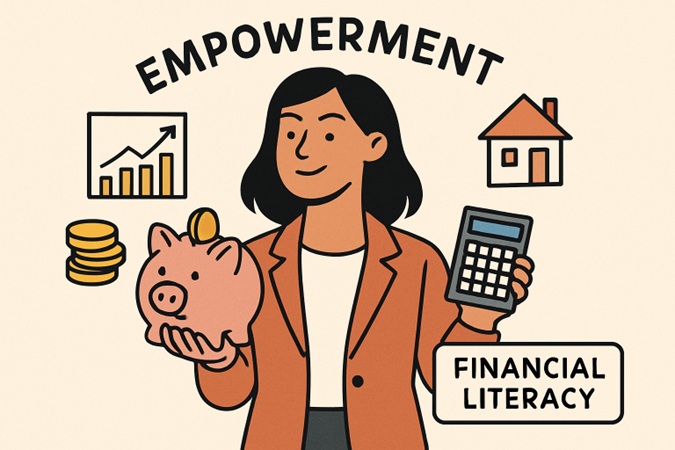Key Takeaways:
- Financial literacy is crucial for women’s economic empowerment and independence.
- Understanding personal finance enables women to make informed decisions and achieve financial goals.
- Access to financial education resources can bridge the gender gap in financial knowledge.
Importance Of Financial Literacy For Women
Financial literacy is not just a skill—it’s a foundation for empowerment. When women possess the knowledge to budget, save, invest, and manage debt, they create pathways to independence and long-term security. Whether striving for personal milestones or supporting their families, women often make crucial financial decisions every day. Resources such as Dow Janes reviews highlight how targeted financial education programs equip women with practical tools for everyday choices, boosting both confidence and outcomes.
According to experts, financially literate women are more effective in handling unexpected expenses and better prepared for retirement, which in turn leads to a healthier overall economy. This individual empowerment is amplified when women have the necessary skills to break cycles of dependency and take charge of their financial futures.
Additionally, empowering women with financial literacy isn’t just about numbers—it means fostering autonomy, improving quality of life, and setting positive examples for younger generations. As more women gain informed perspectives on wealth, credit, and savings, families and communities benefit from greater stability and opportunity.
To fully support women on this journey, it’s critical to address disparities in knowledge and access. Providing relevant education and practical tools, while encouraging a proactive approach to money management, are all essential elements in equipping women to face financial challenges confidently.

Current State Of Women’s Financial Literacy
Despite significant cultural advancements, research from organizations such as Forbes reveals that a gender gap persists in financial literacy worldwide. On average, women score lower than men in financial knowledge assessments, resulting in a gap in wealth accumulation and planning for critical life stages, such as retirement.
This disparity means women tend to save less, invest more conservatively, and are sometimes less prepared to handle significant life changes, such as divorce or widowhood. These financial vulnerabilities can have lasting effects on personal well-being and family stability. Improving overall literacy rates is crucial for achieving economic equality and ensuring both independence and security throughout all stages of life.
Barriers To Financial Education
Multiple barriers contribute to the current state of women’s financial literacy:
- Societal Norms: Stereotypes and traditional roles may shape perceptions of financial decision-making, frequently sidelining women in household or business finance conversations.
- Access to Resources: Fewer tailored educational programs are available for women, especially in marginalized communities or among women returning to the workforce after a career break.
- Confidence Levels: Even well-qualified women sometimes feel unprepared or insecure when making significant financial decisions, causing them to delay taking action or seeking advice.
Overcoming these obstacles requires proactive outreach and inclusive financial education initiatives, ensuring that programs are accessible, relatable, and directly address the unique challenges and needs of women.
Strategies For Improving Financial Literacy
Effective solutions must be both systemic and grassroots, leveraging a combination of proven strategies:
- Educational Programs: Organizations and communities can develop courses that address typical financial hurdles faced by women, emphasizing practical, real-life applications and interactive learning.
- Workplace Initiatives: Employers can offer workshops, benefits education, and resources—helping women employees understand retirement plans, negotiate salaries, and plan for financial emergencies.
- Early Education: Rigorous inclusion of financial literacy in school curricula helps girls develop financial confidence and competence from an early age, paving the way for more secure futures.
Collaboration with local businesses, community centers, and online platforms further extends the reach of these resources, creating a supportive environment for sustained growth.
Role Of Technology In Financial Education
Technology is democratizing access to financial education. With smartphones and computers, women can now reach tutorials, budget calculators, investment platforms, and peer discussion forums at their convenience. Accessible online resources, from video courses to interactive budgeting apps and digital mentorship groups, enable women to learn at their own pace and comfort level.
The Consumer Financial Protection Bureau’s Adult Financial Education Toolkit provides comprehensive materials that help simplify finances for adult learners, covering a range of topics from retirement planning to debt management.
Community Support & Mentorship
Communities and mentorship networks are powerful tools in the journey toward financial empowerment. By connecting with others who share similar experiences and aspirations, women build confidence, access insider knowledge, and celebrate achievements together. Nonprofits and advocacy groups offer group learning, peer-led workshops, and exposure to female financial experts, all of which foster sustainable financial habits.
For example, the National Women’s Business Council is one organization that champions these initiatives, creating spaces for networking, learning, and growing together as financially empowered women.
Policy Initiatives & Advocacy
Large-scale change happens through policy and advocacy. Government mandates requiring financial education in public schools, increased funding for community-based literacy programs, and incentives for employer-led wellness initiatives all play vital roles in promoting financial literacy. Advocacy groups continue to lobby for such policies, ensuring women’s voices and unique needs are represented at decision-making tables. Effective collaboration between public and private sectors amplifies these efforts, moving societies closer to true financial equity for women.
Conclusion
Empowering women with robust financial literacy is a vital step toward closing the gender wealth gap and fostering greater independence for all. By investing in accessible education, leveraging technology, nurturing mentorship and community, and advocating for supportive policies, we build not just stronger individuals but healthier, more resilient societies. Now more than ever, it’s possible—necessary—to support women at every step toward financial freedom.
